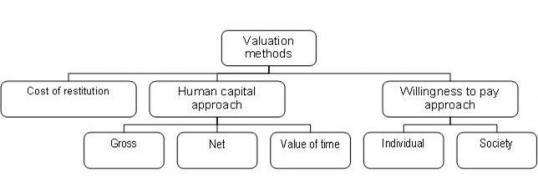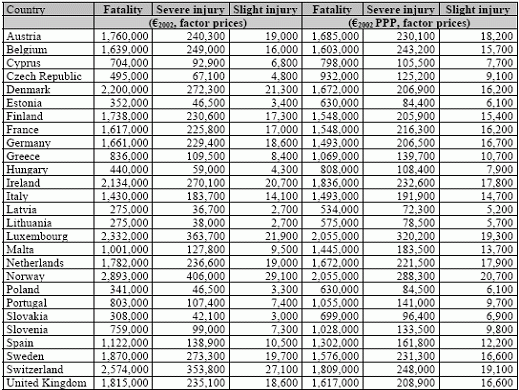Monetary valuation of road safety
Monetary valuation of road safety
When cost-benefit analysis of transport projects started in the 1960s, the only impacts that were included in the first analyses were travel time, vehicle operating costs and accidents. The benefits of preventing accidents were normally valued according to the so called "human capital" approach, which assigned a value to preventing a fatality or an injury proportional to the value of production lost. This had the rather awkward consequence that saving the lives of people outside the labour force, like children or the retired, did not have a monetary value, since these people did not produce anything that had a market value.
Two important papers - one by Schelling [32], the other by Mishan [29] - paved the way for adoption of the willingness-to-pay approach to the valuation of road safety. More will be said about this approach later.
Today, a rather long list of impacts is included in cost-benefit analyses. Table 1 shows the current monetary valuations of impacts of transport projects used in Norway [35]. Even this long list is not regarded as exhaustive. It does, for example, not include habitat intrusion.
Table 1 Monetary valuation of impacts of road transport projects in Norway
Adapted from Statens vegvesen, Håndbok 140, 2006
| Main policy objective | Unit of valuation | Valuation per unit (NOK 2005 prices) |
|---|---|---|
| Road safety | 1 fatality | 26,500,000 |
|   | 1 police reported serious injury (adjusted for incomplete reporting) | 7,800,000 |
|   | 1 police reported slight injury (adjusted for incomplete reporting) | 800,000 |
| Travel time | 1 vehicle hour of travel by means of passenger car | 125 |
|   | 1 vehicle hour of travel by means of van | 140 |
|   | 1 vehicle hour of travel by means of freight truck | 470 |
|   | 1 vehicle hour of travel by means of bus (including passengers) | 860 |
| Vehicle operating costs | Vehicle operating cost per kilometre - car | 1.30 |
|   | Vehicle operating cost per kilometre - heavy goods vehicle | 4.44 |
|   | Vehicle operating cost - bus | 4.82 |
| Environmental impacts | Traffic noise, per vehicle km, large and medium sized towns | 0.38 |
|   | Traffic noise, per vehicle km, rural areas | 0.00 |
|   | Local air pollution, per vehicle kilometre, large towns | 0.25 |
|   | Local air pollution, per vehicle kilometre, small towns | 0.11 |
|   | Local air pollution, per vehicle kilometre, rural areas | 0.02 |
|   | Global air pollution (carbon dioxide), per vehicle kilometre | 0.12 |
| Health impacts | Insecurity in crossing road, per crossing | 1.00 |
|   | Insecurity in walking or cycling in mixed traffic, per kilometre | 2.10 |
|   | Reduction of short term sick leave, walking 1 kilometre | 2.90 |
|   | Reduction of short term sick leave, cycling 1 kilometre | 1.50 |
|   | Reduction of serious illness, walking 1 kilometre | 5.20 |
|   | Reduction of serious illness, cycling 1 kilometre | 2.60 |
As noted above, the first monetary valuations of the benefits to society of saving life and limb in traffic were based on the human capital approach. This approach is still used in some countries and is included as part of the valuation in countries that have adopted the willingness-to-pay approach to the valuation of road safety.
There have been several reviews of the costs to society of road traffic injury. A major review was presented in 1994 by the European Commission: "Socio-economic cost of road accidents, final report of action COST 313" [2]. This report is now more than 10 years old. A more recent survey was made as part of the ROSEBUD-project [5]. This survey first considered methods used in estimating the costs to society of traffic injury, then presented recent cost estimates for selected countries. As far as methods for estimating costs are concerned, the typology shown in Figure 1 was developed in COST-313.
Figure 1: Methods for estimating costs of traffic injury.
The costs of restitution are the direct costs generated by road accidents (for example, medical costs, property damage or administrative costs). Generally speaking, the human capital approach is used to estimate the value of lost productive capacity due to a traffic fatality, whereas the willingness-to-pay approach is used to estimate the value of lost quality of life. Two varieties of the willingness-to-pay approach are normally used: the individual willingness-to-pay approach and the social willingness-to-pay approach. According to the former approach, information about willingness-to-pay is obtained from individuals, either by studying behaviour in situations where reduced risk must be traded off against other commodities or by means of questionnaires. According to the latter approach, society's willingness-to-pay for reduced risk is inferred from the valuation implicit in public decisions like setting speed limits. More information on the different valuation methods is given by Wesemann [39] and de Blaeij et al [5].
Based on a review made by Sælensminde [36], the review of de Blaeij et al [5] and a paper by Tecl and Konarek [37], Figure 2 shows the official monetary valuation of preventing a road accident fatality in a number of countries.
Figure 2: Official monetary valuation of a road accident fatality in selected countries. Euro in 2002-prices.
The valuations vary substantially. An interesting pattern is that some of the countries that have a good safety record, such as Norway, Great Britain, Sweden and the Netherlands, assign a high monetary value to the prevention of a traffic fatality. Some countries with a rather bad road safety record, like Portugal, Spain and Greece, assign a low monetary value to the prevention of a fatality.
The values are determined by two main factors: (1) The method used for estimating them. Values based on the willingness-to-pay approach tend to be about twice as high as values not based on the willingness-to-pay approach.(2) The level of real income in a country. Generally speaking, lower values are found in countries that have a relatively low gross domestic product per capita, higher values are found in the richer countries.
The most recent recommendations for the monetary valuation of road safety are given in a report from the HEATCO-project (Developing Harmonised European Approaches for Transport Costing and Project Assessment) [3]. The recommendations are in two parts.
The first part is a recommendation for adjusting for incomplete accident reporting in official statistics. Recommendations for these adjustments are summarised below (Table 2).
The factors listed are multiplicators, by which the officially recorded number of injured road users should be inflated. A small correction factor is applied to fatalities, due to the 30-day definition of a fatality. Whenever national correction factors are available, these should be used rather than the European average values. Work to develop further correction factors is going on within SafetyNet.
Table 2 Recommendations for European average correction factors for unreported road accidents.
Source: Bickel et al 2006, Table 5.1
The second part of the recommendations is a set of monetary values for the prevention of traffic injury.
The values are listed in Table 3.
Table 3: Recommended values of safety. Source: Bickel et al 2006, Table O.10
There are two sets of values. The first set, denoted factor prices, is based on national currencies. The second set of values denoted PPP; factor prices are adjusted for differences in purchasing power and are therefore intended to be more directly comparable across countries than the first set of values, since the PPP adjusted values account for differences in income and prices between countries.
The HEATCO-report states that values listed in Table 3 should only be used if no national valuation based on the willingness-to-pay approach is available. This recommendation may, however, lead to a dilemma in some cases. In many European countries, studies have been made to assess willingness-to-pay (WTP) for improved road safety. The results of these studies are, however, not always strictly applied in the official monetary valuation of road safety in all countries. Thus, WTP-studies have been made in Belgium [7], Denmark [25], France [10], Great Britain [24], Greece [41], the Netherlands [4] and Sweden [31] all showing considerably higher figures for the willingness-to-pay for road safety than the official valuations used in these countries. Although the official valuations of road safety in most of these countries are based on the willingness-to-pay principle, the valuations represent a very conservative interpretation of the results of the studies that have been made.
An analyst basing the analysis directly on the WTP-studies quoted above, and not on the official monetary valuation of road safety in the respective countries, would, all else equal, find more road safety measures to pass the cost-benefit test than an analyst basing the analysis on official valuations. Thus, if the findings of WTP-studies are taken seriously, it would seem that the officially used monetary valuation of road safety in many European countries today is too low. This is the case even if the lowest estimates emerging from WTP-studies are used.
The main argument for interpreting WTP-studies conservatively is that there are numerous sources of error associated with such studies that may lead to inflated valuations. This point of view is correct, but a detailed discussion of it would go beyond the scope of this introduction. The details about how to perform a study of the willingness-to-pay for road safety are a hugely complex topic. An accessible, yet quite profound introduction to the topic is given in a book by Jones-Lee [23].




